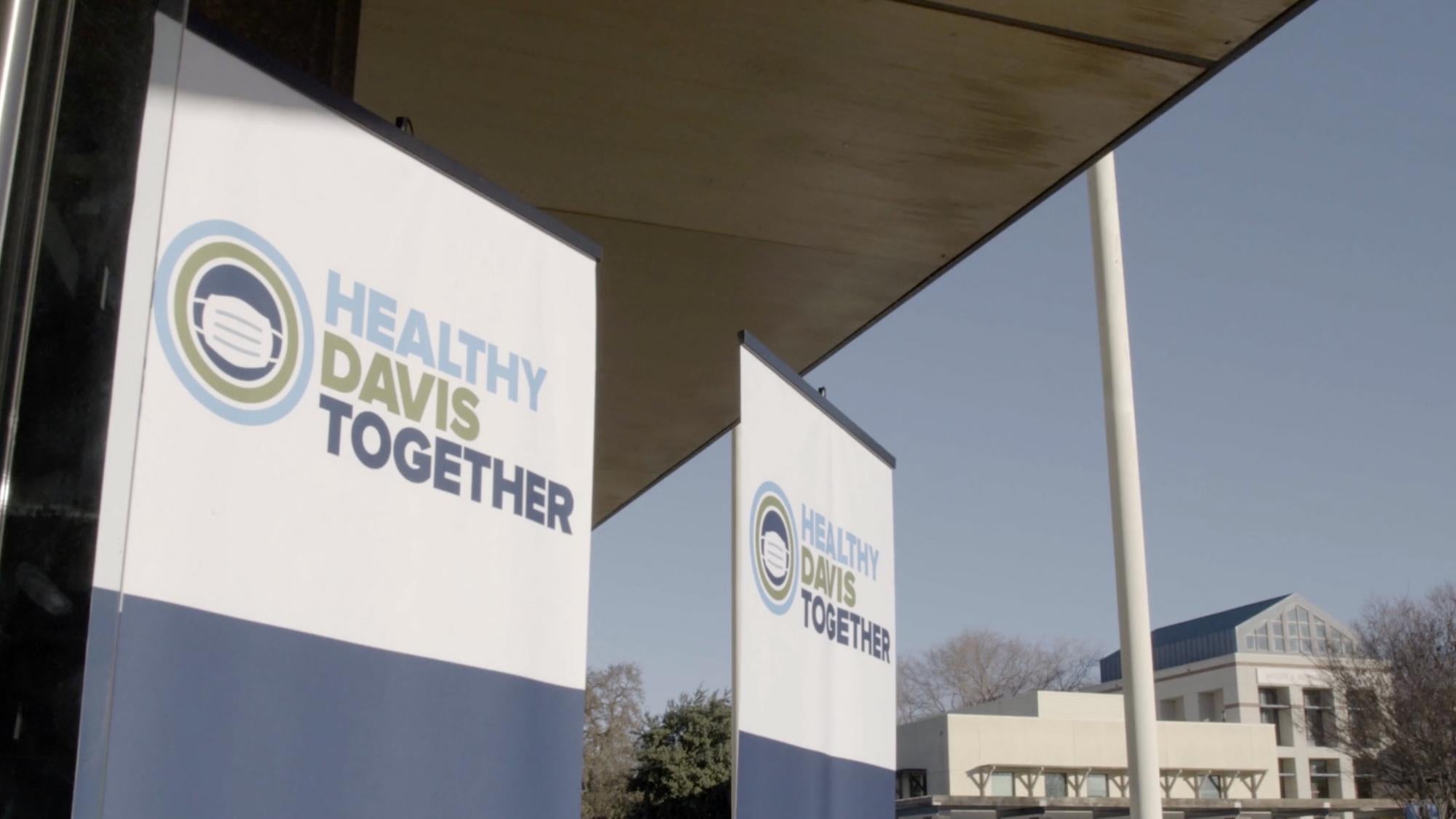Since fall 2020, under the banner of Healthy Davis Together, UC Davis and the city of Davis have been working together on an unprecedented scale to fight the COVID-19 pandemic. The messages, for the most part, are familiar across most of the country: practice physical distancing, wear a mask, get vaccinated as soon as you can. But Healthy Davis Together, or HDT, goes far beyond urging people to protect themselves and others. As the pandemic — we hope — winds down, could this be the future of public health in America?
HDT includes a range of activities aimed at keeping COVID-19 at bay. Central to these is free saliva-based testing for people without any symptoms, available at locations on campus and in the city and typically delivering results within 24 hours. For people who test positive, the program has boosted numbers of investigators and contact tracers, and it can provide assistance in finding a place to isolate and stay away from others if needed.

Imagine a place where creativity connects ideas from obvious to outlandish.
Find out how UC Davis outgrows the expected.
For local businesses, HDT has supplied free masks and other protective equipment and given advice and incentives for safe practices — as well as offering incentives to students to shop locally.
The idea was to take the best available COVID interventions and apply them all at once to a whole community. — Brad Pollock, associate dean and chair of public health sciences at UC Davis and director of HDT
HDT worked with the Davis Joint Unified School District to safely reopen schools, including piloting testing classroom air for viruses. The program is also monitoring wastewater on campus and in the city for early warning of outbreaks.
And as vaccines have become available, HDT is bringing them to the most vulnerable and underserved populations in the county.
“The idea was to take the best available COVID interventions and apply them all at once to a whole community,” said Professor Brad Pollock, associate dean and chair of public health sciences at UC Davis and director of HDT, speaking at a June 23, 2021, webinar.
Asymptomatic testing and Aggie health ambassadors
Early in the pandemic it became evident that widespread testing would be a vital tool to control COVID-19. A central component of the UC Davis response to the pandemic, and of HDT, was to make rapid, saliva-based testing available through the university’s Genome Center. Richard Michelmore, director of the Genome Center and professor of plant sciences, led the team that developed and implemented the testing program.
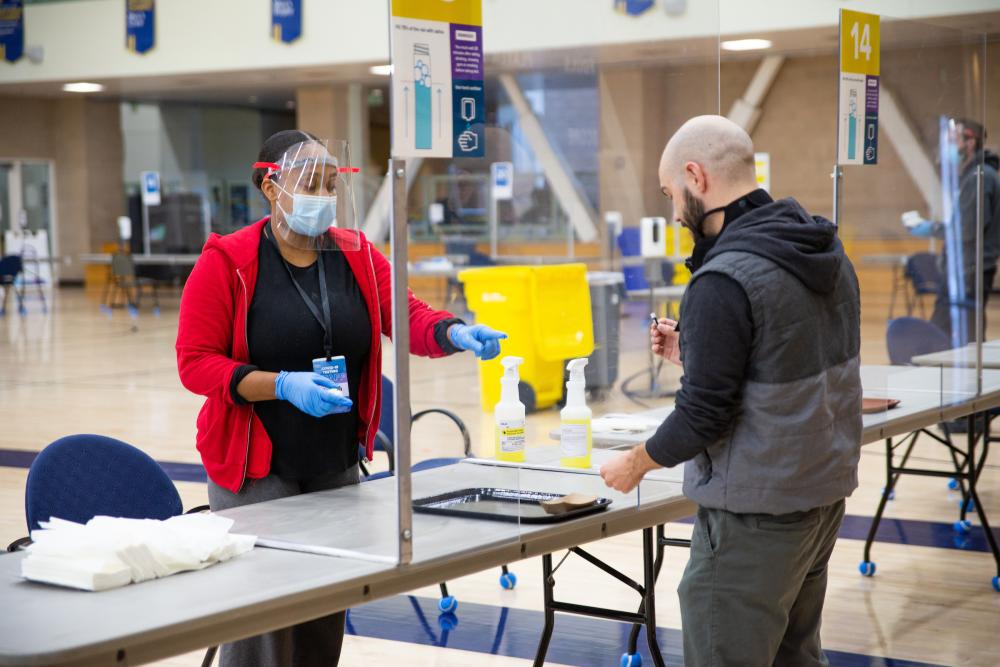
UC Davis began offering tests to students in mid-September and, through HDT, to the local community in November 2020. After a year of testing, the Genome Center has processed just over 800,000 tests and found 4,444 positive cases.
In preparation for at least some students, faculty and staff returning to campus in fall 2020, the university also hired some 250 students as Aggie Public Health Ambassadors. Their role was to model healthy behavior, educate people about campus protocols and encourage everyone to make healthy choices. The ambassadors were stationed at high-traffic campus locations, handing out free face coverings, pointing people to hand-washing stations and COVID-19 testing locations, and providing tips on staying healthy.
By Thanksgiving the ambassadors rolled out to the Davis Farmers Market and then other locations in downtown Davis. — Brad Pollock, associate dean and chair of public health sciences at UC Davis and director of HDT
The goal of the ambassador program was education rather than enforcement, promoting a positive culture of health, shared responsibility and personal accountability. The ambassadors were trained and supervised by faculty from the Department of Public Health Sciences at the School of Medicine in collaboration with Student Affairs.
“While this program started out to help educate people on the UC Davis campus, by Thanksgiving the ambassadors rolled out to the Davis Farmers Market and then other locations in downtown Davis. This was a major public health intervention,” Pollock said.
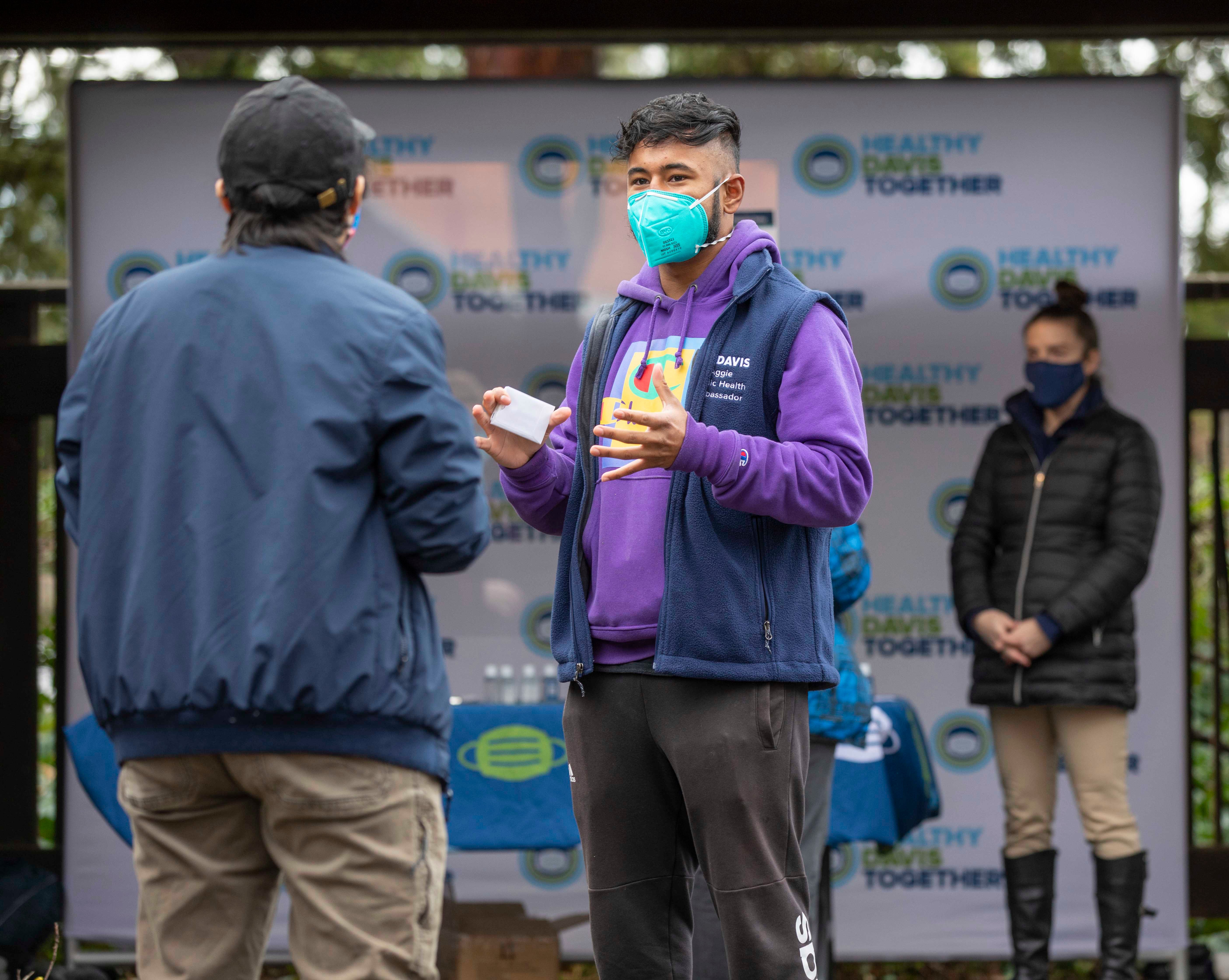
Protecting a community
While Michelmore’s team was working to set up testing, wider moves were underway to throw a protective shield over the Davis community.
In June, Davis City Manager Mike Webb took a short phone call with Dr. Tom Nesbitt, emeritus associate vice chancellor for Strategic Technologies and Alliances at UC Davis Health. Would the city be interested in a joint project on controlling COVID-19?
“It was just a 50,000-foot concept, but my response was, ‘We’re all in,’” Webb recalled.
Over the next few weeks, a team of campus and city officials including Webb, Pollock, Ken Burtis, emeritus faculty advisor to the provost and chancellor, Tod Stoltz, director of business development at UC Davis Health, and others put together a proposal for what would become HDT.
“We wrote the planning grant over the July 4th weekend,” Stoltz said. “We wanted to move fast and try things.”
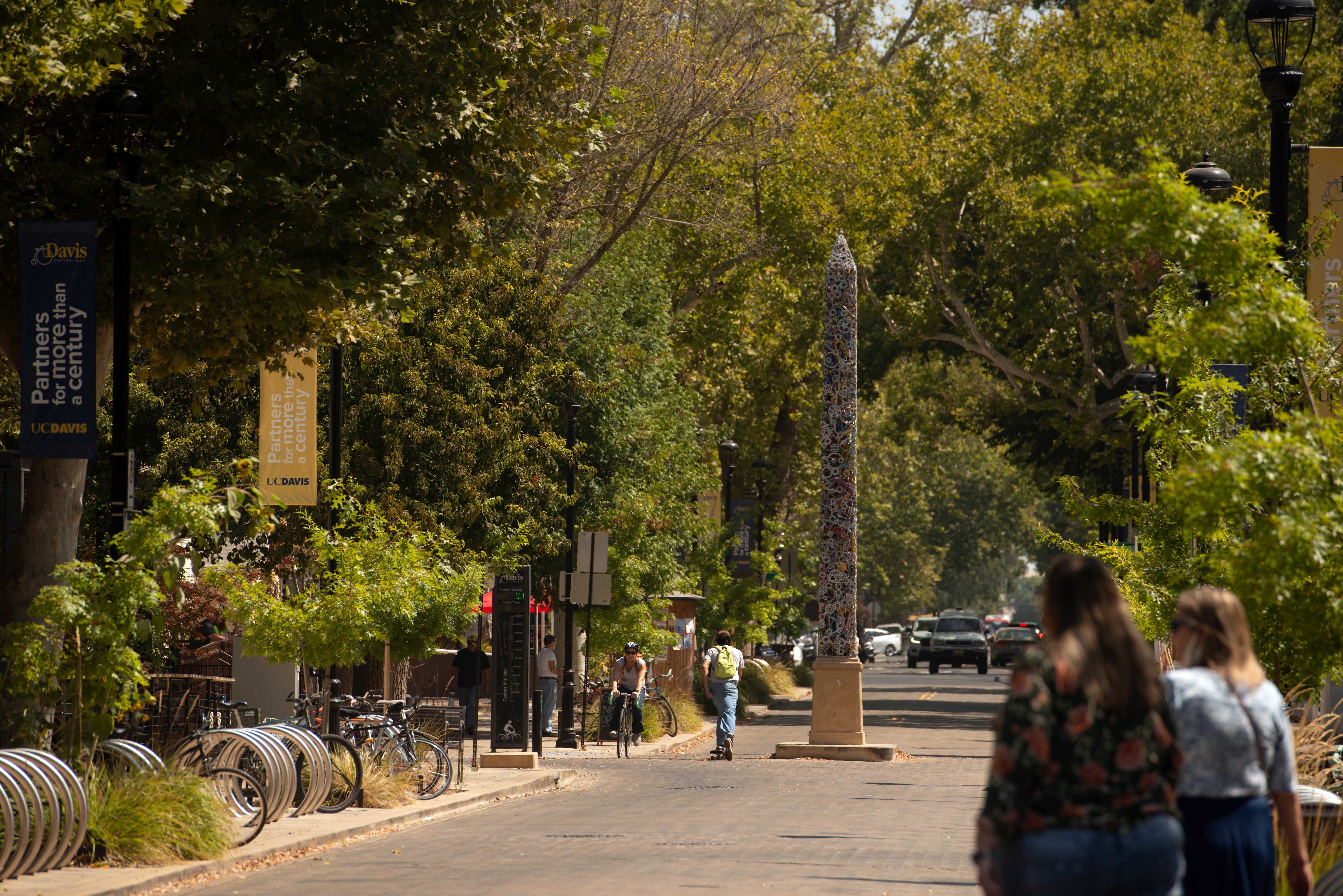
“We gave ourselves permission to stretch the boundaries,” Webb said. “We knew some things might fail — we wanted to try things and see what worked and then share that with others.”
The general concept, Stoltz explained, was to use resources up front to stop the pandemic from gaining a hold in the Davis community, rather than having to go through cycles of opening up only to have to close down again as infections surged back.
We gave ourselves permission to stretch the boundaries. — Mike Webb, Davis city manager
Campus and city officials formed an executive committee, meeting multiple times a week to make major decisions. Pollock, the project director and chairman of the executive committee, along with Burtis and later Stoltz as chief operating officer, worked to assemble the other team members and bring in consultants and contractors to help run programs, and a public relations agency to develop advertising and communication strategies. The project was funded with a mix of university funds, state and federal grants and philanthropy.
Just before Thanksgiving 2020, HDT began offering the Genome Center’s COVID-19 tests, first at the Davis Senior Center and then in December at the Mondavi Center.
Supporting contact tracing and isolation
To control a disease like COVID-19, you need to know who is infected, where they likely got infected and who else they might have exposed. Then you have to find those other exposed people and isolate them to break the chain of infection. This is called case investigation and contact tracing. On the UC Davis campus, this was managed for students by Dr. Cindy Schorzman and her team at Student Health and Counseling Services, and for employees by Dr. Karega Paisley’s team in Occupational Health Services.
Within the rest of Yolo County, including the city of Davis, the Yolo County Health Department is responsible for case investigation and contact tracing. But the county’s resources were already stretched thin in mid-2020, and if the asymptomatic testing started finding more cases to run down, they could be overwhelmed.
This probably played an important part in keeping our case rates low. — Sheri Belafsky, director of medical surveillance in the UC Davis Department of Public Health Sciences
To prevent this, more contact tracers were hired through HDT. Sheri Belafsky, director of medical surveillance in the UC Davis Department of Public Health Sciences, stepped in to oversee that effort. HDT signed a memorandum of understanding with Yolo County, allowing their case investigators and contact tracers to train and work together. Many of the case investigators hired by UC Davis are graduate students, Belafsky noted, which provided them with excellent training in public health.
“We were extremely busy all through summer and fall,” Belafsky said.
Up to Sept. 19, 2021, the UC Davis testing site had collected 479,930 samples of which 941 (0.2%) were positive. The testing sites in the city of Davis had collected 351,236 samples of which 3,382 (0.97%) were positive.
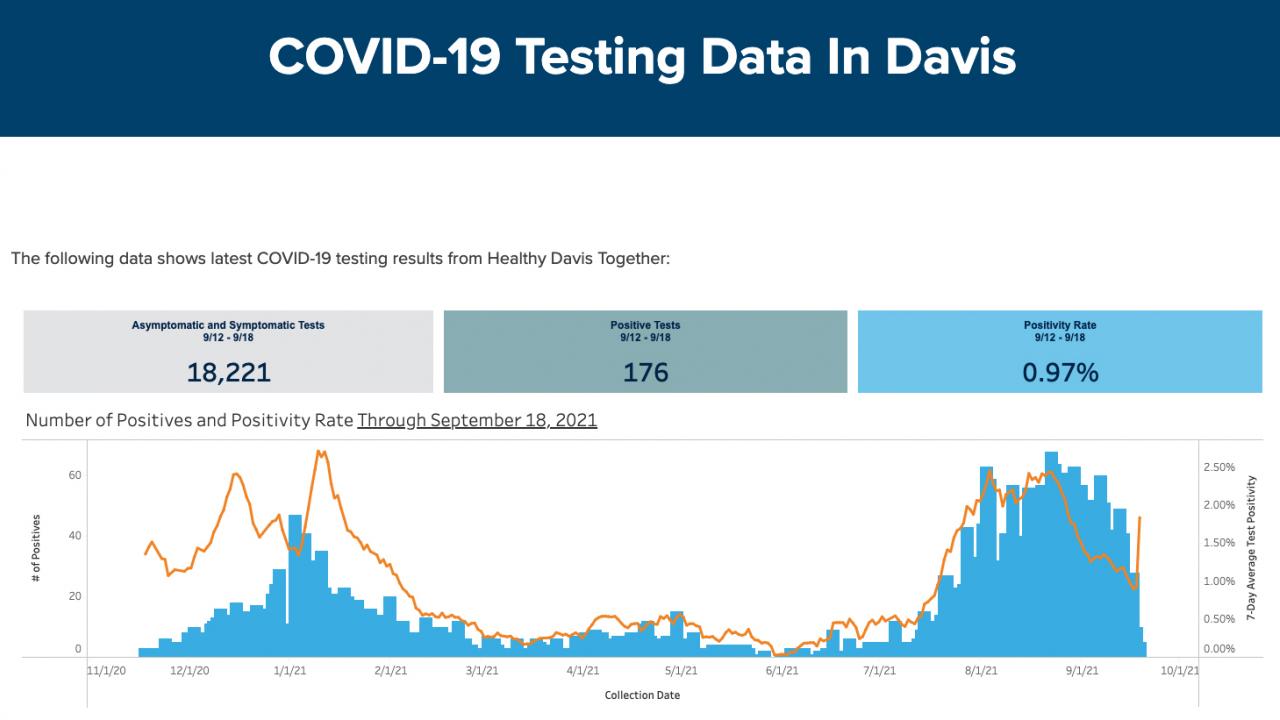
When a sample tests positive, Belafsky said, a nurse from the medical team calls the patient within an hour to discuss the diagnosis and see if they need further interventions right away. In many cases, patients already have a primary care provider that they can see.
“If they don’t have a health care provider, we connect them with one,” Belafsky said. HDT partners with CommuniCare, a federally qualified health center that provides health services in Yolo County, for patients who do not have health insurance.
The care team can arrange isolation housing and even groceries if needed. On campus, UC Davis set aside blocks of student housing for students who need to isolate. In the city of Davis, Tandem Properties offered furnished apartments at a reduced rate to HDT, which were then available free of charge to those who need them for isolation.
Within 24 hours of a positive test result, case investigators begin looking at the patient’s movements and activities while they were likely infectious. Contact tracers reach out to people who were exposed to the patient to advise them to get tested and, if necessary, to isolate. Results are also reported to the Yolo County Health Department and the California Department of Public Health as required by law.
It’s a labor intensive, high touch process, Belafsky said.
If the roughly 2,000 people identified through asymptomatic testing had gone undiagnosed, they likely would each have infected many more people, multiplying exponentially the number of local cases.
“I think this probably played an important part in keeping our case rates low,” Belafsky said.
Supporting downtown Davis
With city staff already stretched thin by the pandemic, support from HDT allowed the city to bring in consultants to manage different parts of the project.
Supporting the local economy was a key priority for city leaders. In partnership with the Chamber of Commerce and the Downtown Davis Business Association, HDT delivered face masks and other protective equipment and advised businesses on social distancing precautions. Local businesses could sign up to be on a list of those practicing good COVID-19 safety precautions.
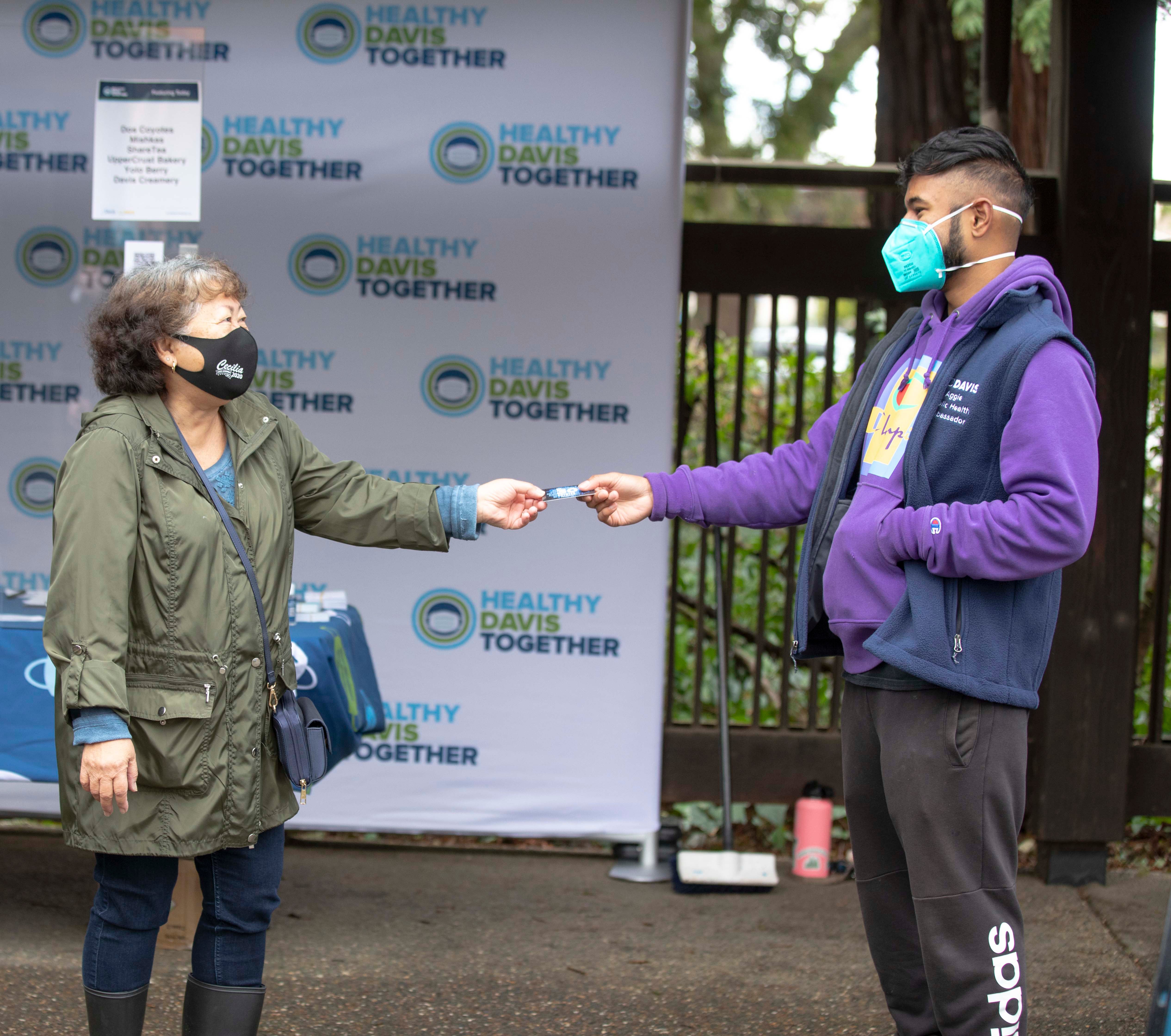
The program also purchased gift cards from downtown businesses, giving them out as incentives for people to get tested or as “rewards” at testing sites.
“This was a way to retain spending locally,” Webb said. “People are going to purchase products and services anyway — let’s encourage them to do it locally.”
Community surveys carried out by EMC Research as part of HDT show a high rate of satisfaction, Webb said.
“The community response has been tremendous,” he said.
Vaccinating underserved populations
The test positivity rate peaked at 2.7% in early January in the city of Davis, compared to 17% statewide at the same time. The Davis numbers were likely lowered because HDT was actively encouraging asymptomatic people to get tested.
As case rates fell and the vaccine rollout began, HDT took on vaccine distribution as well, focusing on underserved populations.
“The county and private clinics seemed quite successful, so we wanted to put our efforts onto those with transportation, technology or language barriers to getting the vaccine,” Belafsky said.
We wanted to make it as easy as possible for patients to get to us. — Sheri Belafsky, director of medical surveillance in the UC Davis Department of Public Health Sciences
In partnership with Yolo County and community organizations, HDT has set up vaccine clinics in Woodland and West Sacramento. They opened a call center to do outreach by telephone.
“We wanted to make it as easy as possible for patients to get to us,” Belafsky said. By mid-September, HDT had vaccinated almost 15,000 people and made thousands of phone calls to county residents who missed their second dose.
HDT also ran mobile vaccine clinics at county homeless shelters and migrant worker housing, and went door-to-door at motels with the county homelessness coordinator.
The future
On June 15, 2021, California officially reopened its economy, ending many statewide measures: Yolo County followed the state’s lead. But mask mandates were reimposed later in the summer as the highly infectious delta variant drove a surge in cases. In July, the University of California announced that with very few exceptions, all students, faculty and staff would be required to get vaccinated before returning to campus for fall quarter.
The pandemic is far from over, and HDT is entering its second phase. Priorities for this new phase of HDT will include testing in schools, environmental monitoring, vaccination and sharing the knowledge gained from the program with other communities, Stoltz said.
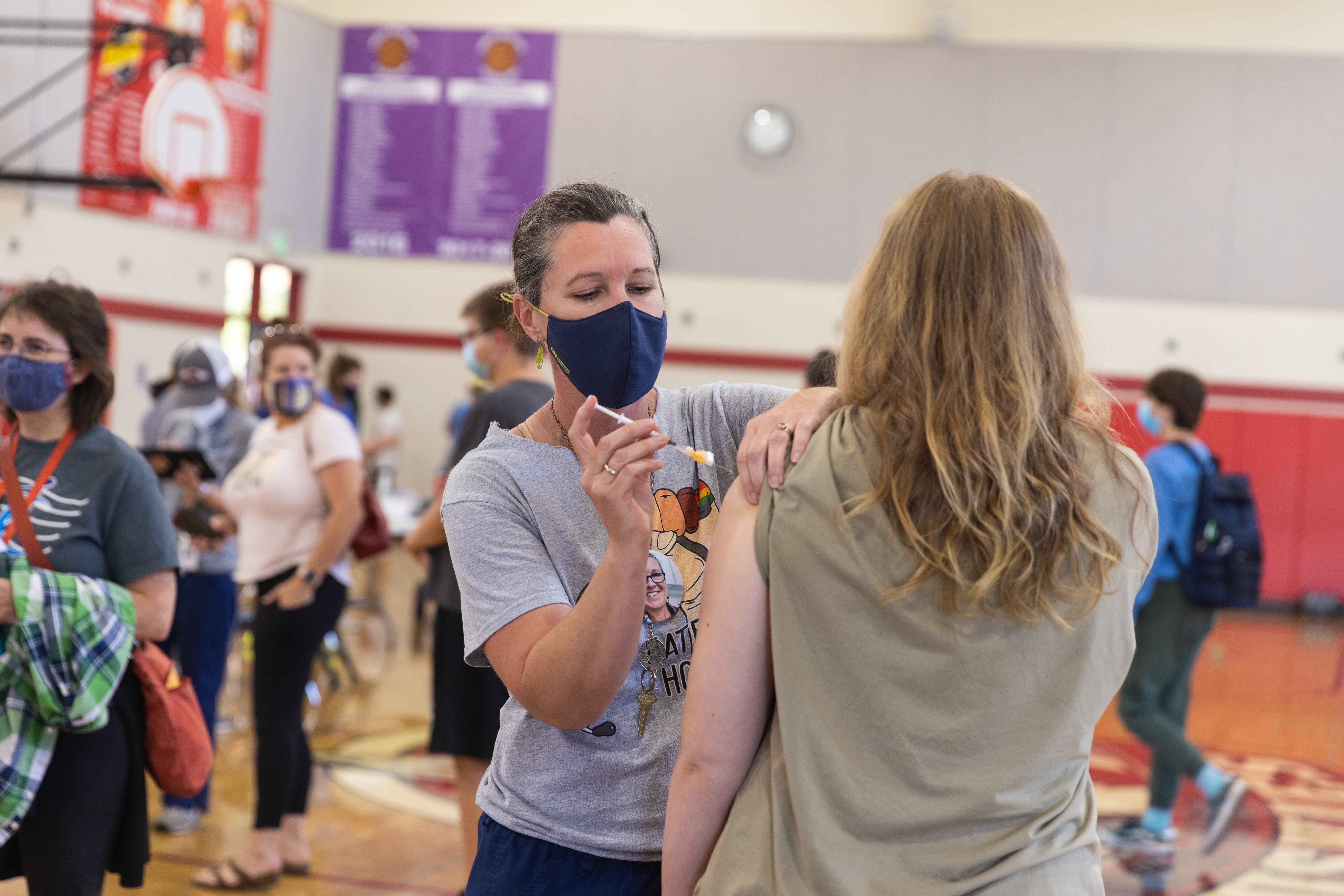
At the UC Davis Genome Center, Michelmore said, test throughput has increased to over 7,000 samples per day to accommodate the full opening of campus.
Davis schools reopened for in-person classes in April, with HDT providing on-site testing. That testing has expanded to schools in Woodland and the rest of Yolo County. The UC Davis Genome Center ran a pilot project placing air filters in classrooms at five Davis elementary schools to test for airborne SARS-CoV-2.
Another way to screen for COVID-19 in the community is to look in the sewers. Heather Bischel, assistant professor of civil and environmental engineering, led a project to set up testing of wastewater for the virus, first on campus and then, in collaboration with the city’s public works department, in Davis neighborhoods. By detecting virus in a particular neighborhood — or on campus, in a specific residence hall — health authorities can focus testing and vaccination outreach in specific areas that may have an active outbreak.
Sharing the knowledge
HDT was conceived as an experiment: Could a community take coordinated action to protect itself from the worst effects of the pandemic? Over the past 10 months, HDT has carried out COVID-19 tests and distributed face masks and other supplies by the hundreds of thousands. They’ve come up with innovative programs in vaccination, outreach and in supporting businesses. Now the knowledge is being shared through a series of documents available online. Researchers also hope to submit papers to peer-reviewed journals, Michelmore said.
This won’t be the last pandemic to threaten the world. At the time of writing, we are not even out of the current one. The Genome Center types all positive samples against known variants. By the end of June 2021, half of the positives in Yolo County were the highly infectious delta variant.
This is probably the closest relationship between the campus, the town and the county that I can remember. — Ken Burtis, emeritus faculty advisor to the provost and chancellor
So far, the available vaccines work against delta and other known variants, but Michelmore worries that a vaccine-resistant strain is bound to appear sooner or later.
Could the HDT approach be expanded statewide or nationwide? It would be expensive — a very rough calculation put the cost of a program like HDT at a national scale at about a half-trillion dollars, Burtis said, leaving aside other political factors.
“But consider that Congress has already spent trillions of dollars on pandemic relief, and then there’s the value of all the lives that have been lost,” Burtis said.
One local benefit is the new relationships and connections that have been built between city and campus.
“It’s been a tight collaboration,” Burtis said. “This is probably the closest relationship between the campus, the town and the county that I can remember.”
Burtis noted that UC Davis is not the only university to offer widespread testing on campus.
“But I think we’re fairly unique in offering it to the whole community as well,” he said.
From the city side, Webb said the collaboration had brought new ways for city and campus to converse about issues.
“I’m so extraordinarily proud of what we have accomplished, we couldn’t have done it without each other,” Webb said.
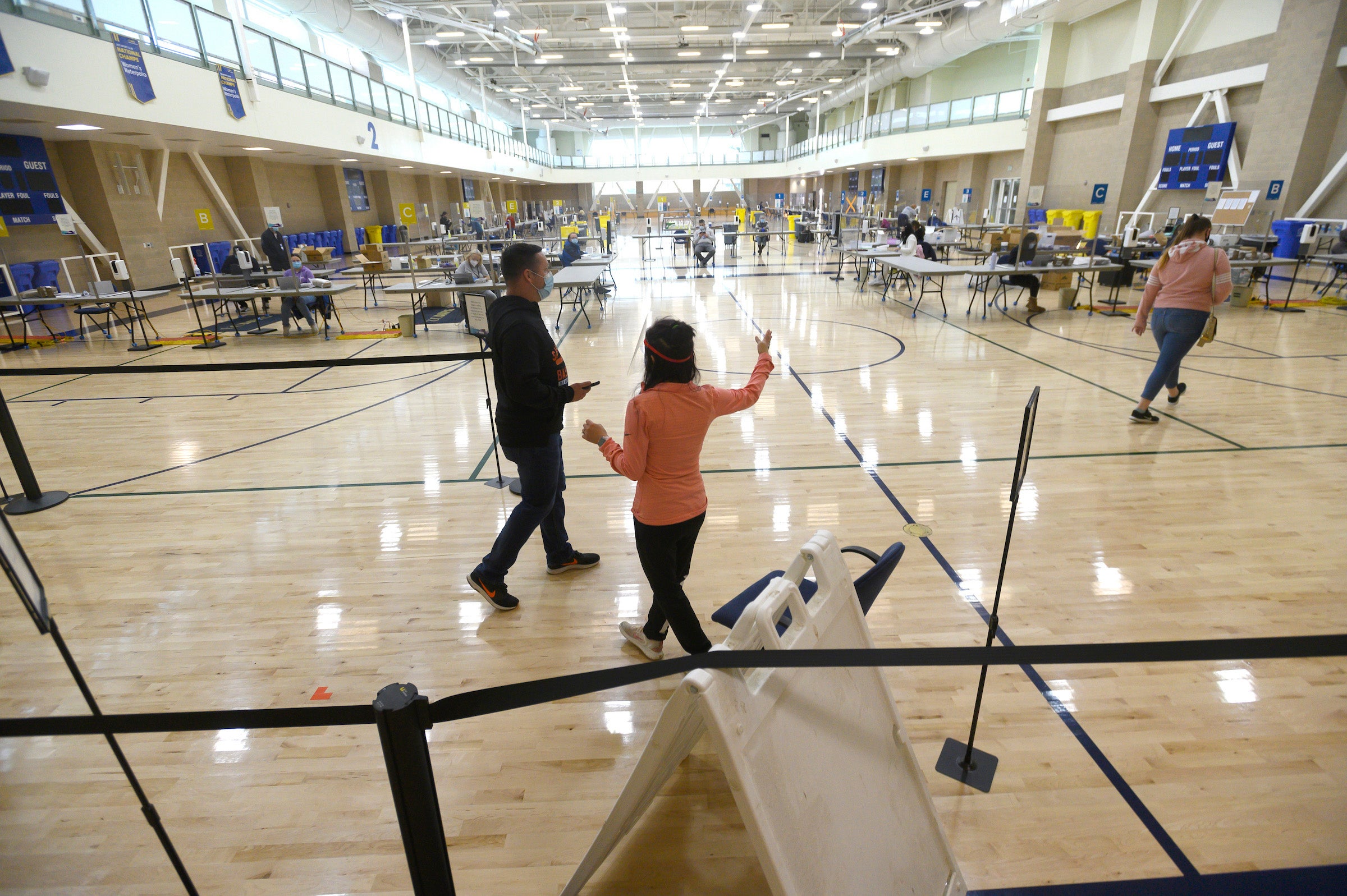
Related Stories
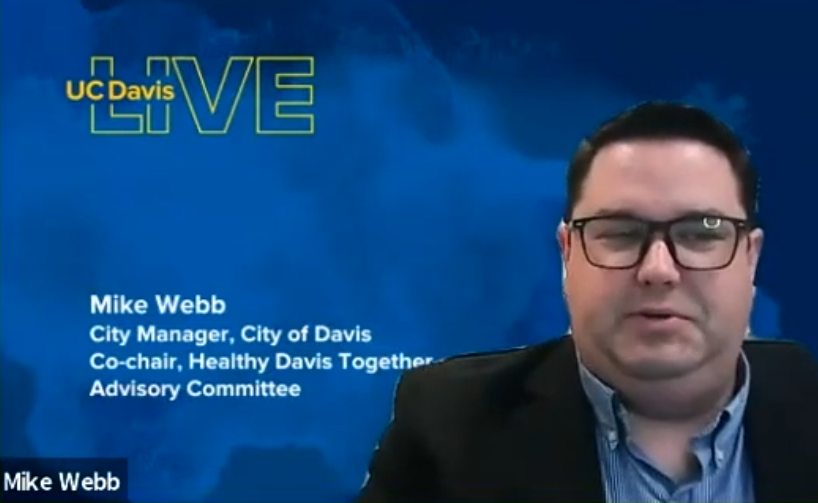
Watch: UC Davis Live discusses the formation of Healthy Davis Together
Tod Stoltz, director of business development and international affiliations at the UC Davis Center for Health and Technology, and Davis city manager Mike Webb talk about how Healthy Davis Together came to be.
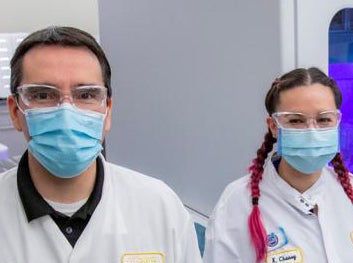
A race against the COVID-19 virus
Here's how the UC Davis Department of Pathology and Laboratory Medicine created its COVID-19 test in 19 days.
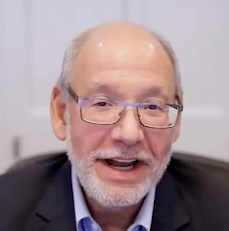
Watch: WebMD says HDT is a 'model for community control of COVID-19'
Dr. John Whyte with WebMD, the popular medical website, interviews Dr. Brad Pollock, associate dean and chair of public health sciences at UC Davis and director of HDT.
Media Resources
"A California University Tries to Shield an Entire City From Coronavirus" (The New York Times, Jan. 30, 2021)
Media Contact:
- Andy Fell, UC Davis Media Relations, ahfell@ucdavis.edu; 530-752-4533
